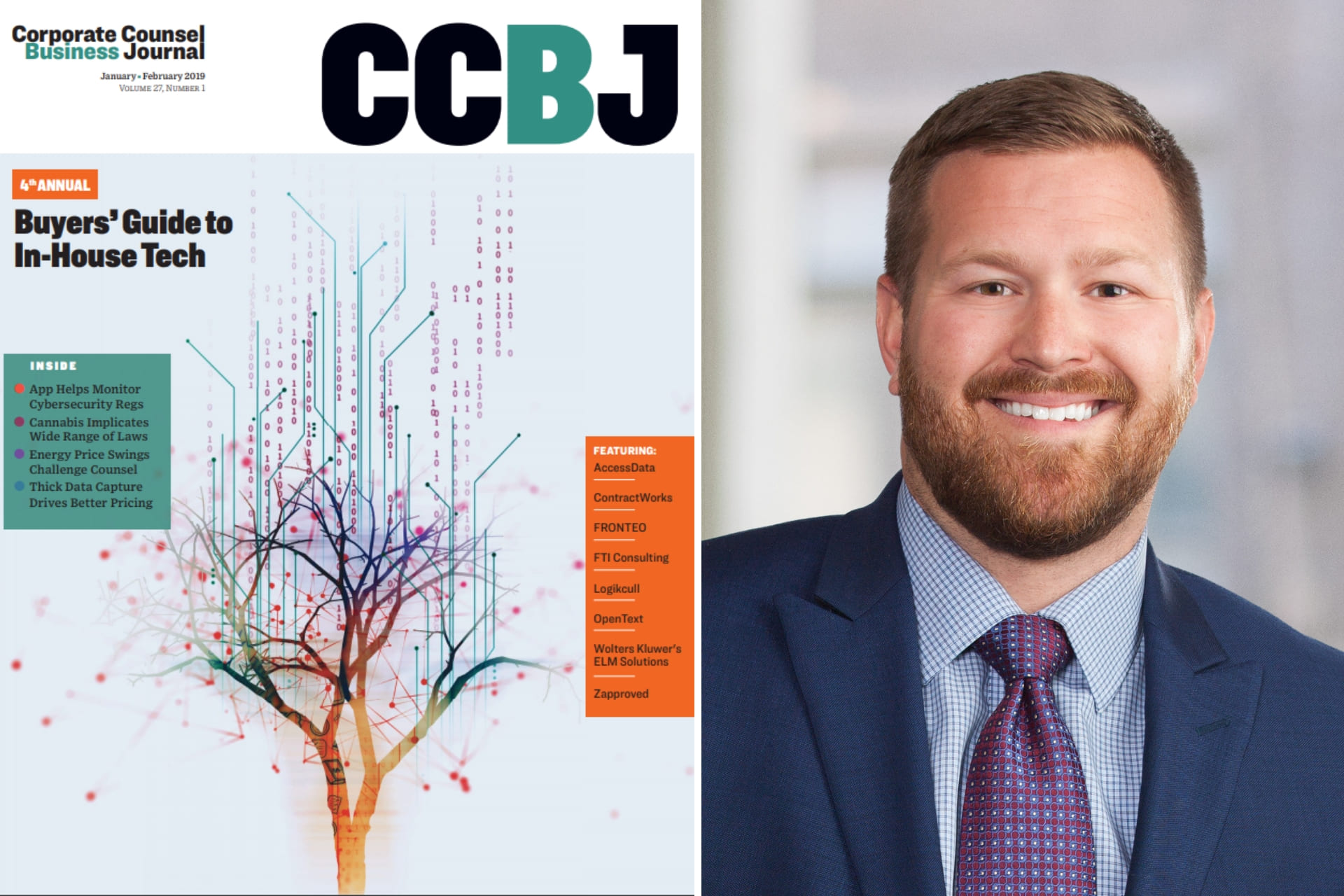This interview with Barnes & Thornburg's Jared Applegate was originally published in the January/February 2019 issue of Corporate Counsel Business Journal.
CCBJ: Both law firms and in-house law departments look to gain pricing certainty from a better understanding of data related to matters. What type of data should be focused upon?
Jared Applegate: From an in-house law department perspective and, frankly, from a law firm perspective, I think you always want to start with the end in mind. Ask these questions: At the end of the day, what business decisions will be driven by the capture and analysis of the data? Will that ultimately provide greater value/insights to my business unit leaders?
The understanding of data related to matters, or a portfolio of matters, of price certainty is extremely important for both law firms and in-house law departments. However, I believe there’s really a bright line between the gathering of big data versus the gathering of thick data. The legal industry is far from the point where big data can be extrapolated that effectively. The practical focus should be on thick data and thick data sets, which means you have a tight team of folks working on a particular practice area or working on a particular type of matter, and they run that same matter the same way each time, or it’s in a portfolio set. And from there, a thick data set and better understanding of data related to matters can be extrapolated for price certainty.
If you are in-house, can you start to tackle data based on areas of law that help your business and with firms that you already partner with? I think the answer is yes. From there, you can then evaluate the thick data set that could lead you to: defined outcomes, high/low price points, cycle times and other key performance indicators (KPIs) over time.
What is the best way for a larger institution to gather useful data, and what trends can the data identify?
It is critical to understand where the data’s coming from. It’s the garbage in, garbage out theory. From an in-house perspective, it’s about what data you want to capture that you believe is useful, and then how you go about gathering data. New business intake is a great way to look at how you bring data into an organization, and what the best practices and protocols are around that workflow.
Depending on who is inputting the data, they may find holes in the system – a reason to not input particular data. So it’s also about trying to plug those holes in how data is captured, and making sure that everybody involved is invested. It’s important to clarify that across functionalities and roles within the organization, and to know who you teach the “why” versus the “how.” A subset group might need to know why they are capturing data in the first place, while another subset group might need to understand how the data is captured.
On the law firm side, many firms utilize both a new business intake system for data capture as well as data captured in the accounting system. One can spot trends across portfolios of matters, especially staffing resources. We can identify what clients are coming to us from specific industries, and how we treat those specific industries internally. When a firm has an expertise in an industry, it helps to identify and collect a significant amount of data quickly when all the parties are really engaged in capturing that information.
What are common struggles that organizations have, and how can inside and outside counsel work together to ensure success? What is similar between the two entities, and what’s different?
When it comes to inside and outside counsel working together, there can be several struggles. For example, wanting to use alternative fee arrangements but at the same time wanting to review and look at itemized invoices. But both parties have to have a common understanding or agreement. Organizations like CLOC and ACC Legal Ops are trying to tackle this by creating a standard around the industry on better data practices and better data capturing. I think both groups are doing a good job of pairing legal ops leaders with law firm leaders to hear different perspectives around these types of issues. Concurrently, Standards Advancement for the Legal Industry (SALI) Alliance is moving towards standardizations, similar to SKU numbering, and is seeing promise on both the in-house and law firm side.
But in the trenches, how you work with your counterparts starts with conversation. Many of these discussions between inside and outside counsel really revolve around trust – that you’re getting relevant legal advice and relevant value. So how the value of a particular service is perceived is really important. If you have a subset of law firms that you are working with, it’s a good idea to have a dialogue with them about what data they’re capturing and why.
We frequently have these conversations with our clients. Most recently, we were working with a client who was capturing basic Uniform Task-Based Management System (UTBMS) phases and task codes internally through e-billing, but a good portion of their legal spend was in a very niche practice area where the UTBMS codes do not effectively work. As the discussion evolved, we suggested that our firm create our own because it would help us compartmentalize some of our services. And it was in a niche practice area where we have tight teams, and those teams go out and deliver a similar service across a platform. From there we started using a proactive phase and task code set inside of all the matters that ran through that specific practice area. It became a really strong initiative, because it allowed us to one: build more accurate budgets, and two: create effective alternative fee arrangements for pieces of work in the niche area of law. And then, of course, internally, be able to track our outputs. Essentially, we turned a budget into an actionable tool.
The client saw our phase and task code list and recognized how it was different than what their other firms were doing. They may adopt it themselves, or maybe not. But giving them the ability to see how we did it is pretty effective.
With better data capture initiatives comes technology to scale. How did your firm get attorneys to embrace the use of technology to improve processes and performance? What were the incentives?
It’s important to understand all of the technology solutions available to you and your clients. For us, process improvement was about identifying a technology resource that had the ability to scale with us – in other words, putting a dashboard in front of every attorney to better understand and visualize data to be empowered to make decisions.
From there, it was about doing what we consider basic blocking and tackling, selling that program internally. The tech itself is really only part of the solution. It’s important to share why it is a good practice and educate others on its use.
One incentive was that, before the dashboard implementation, attorneys had a hard time really doing active, real-time matter management. Now with a robust dashboard that displays KPIs and rich data, they’re able to see what’s going on in real time, and not just 30 days later.
What are some best practices for operations professionals trying to incorporate dashboards or other new technology into their law department?
It’s been a top-down effort for our firm. For somebody trying to do this in a law department, it’s about how to bring in the new technology or process and what the relevant information to show is. Reaching out to law firms that have done that already is a good first step to take. Another is identifying a service provider that’s going to actively participate and allow you to curate the features in the best way for your team.
Being flexible in the approach is key. And perhaps occasionally your company will adapt to your law firm’s methods, because it’s the path of least resistance. In many ways, it can be as simple as defining the most relevant data lawyers should know and understand, and making it easily accessible; therefore, helping them make well-informed decisions quickly.
It is a commitment to continuous training along the way. It’s one thing to bring in a piece of technology. It’s another thing to bring in a new process. And you have to do both.
Jared Applegate is the director of pricing for Barnes & Thornburg. He provides market insight, competitive intelligence and innovative thinking on pricing strategies and related matter management solutions.














